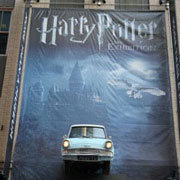The Harry Potter exhibition opened in Times Square this week with a gala event that included appearances by members of the cast, a red carpet and a preview of the exhibit.
If you’re in New York, you’ll want to get to the Discovery Center in Times Square. The exhibit is amazing and for anyone who loves these books and movies, it will give you a unique immersion in the world of Hogwarts. As a fan, I was surprised by how exciting it was to see all of this stuff in person.
We also got a chance to meet some of the cast (exciting!) at a morning press conference and hear about how this experience had been for them. It was fascinating to hear from producer David Heyman about how the films came together and the chance to work on the stories over the past decade. Heyman talked about the richness of the imagination that went into all the productions. When they started out, they knew that they would be making two films, but they had no idea that it would become the global phenomenon that it has become.
Harry Potter, in fact, has joined the pantheon of children’s characters, movies and books that will likely be read a century from now, and it’s exciting to talk to kids who weren’t even born when the first book came out and to hear how they are just as excited about the world of Hogwarts as the original Harry Potter kids, many of whom are finishing up college now.
But the appeal of Harry Potter should come as no surprise. It draws on the classic structure of almost all enduring children’s literature and has roots that go back to “The Illiad” and “The Odyssey.” A hero, in this case a wizard who miraculously survived an attack, must face enemies, overcome all kinds of horrible odds and emerge triumph, if changed, at the other end. The Harry Potter series has been a classic coming-of-age story wrapped in the wonderful, imaginative world created by J.K. Rowling and brought to life in all of the movies. (“Harry Potter and the Deathly Hallows, Part 1” comes out on DVD this week.)
The Harry Potter myths share one other element with classic children’s literature—the parents are gone. Thus, Harry and his friends have to fend for themselves, solve problems for themselves, question authority when necessary within the context of a world that is alien and hostile toward them. Moreover, the rules of fair play, honor, friendship and doing what’s right all exit within the context of this world, and it’s up to the kids to find their way without compromising their values.
These are lessons we always strive to teach our kids, and we hope they learn. When they come to life in the guise of fiction and films, kids are more likely to internalize these messages in the abstract, and, we hope, integrate them into their own lives.
That’s what makes these books timeless, and why your children will want to share them with their grandchildren.

